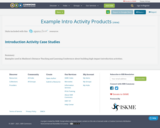
Examples used in Madison's Distance Teaching and Learning Conference about building high-impact introduction activities.
- Subject:
- Education
- Material Type:
- Activity/Lab
- Case Study
- Date Added:
- 07/05/2017

Examples used in Madison's Distance Teaching and Learning Conference about building high-impact introduction activities.

Ένας οδηγός μελέτης για το Excel

National findings on formal training and education of migrants with focus on empowering their transversal skills that partners identified in IO2 as instrumental to favour their integration in the tourism sector, and more in general, in the overall labour market. The videos of the experiments are available on our project website : https://citiesbyheart.aeva.eu/index.php/portfolios/io5/

Imagine trying to cut your hair without metal tools. How would you do it? Join JPPM's Educator Nate Salzman as he uses experimental archaeology to answer the question "How did Native Americans cut their hair before metal tools?" Use to support the Maryland Social Studies Framework for grades 3, 4, and High School. To support the grade 3 content topic "Cultural Change Over Time," have students compare the advantages/disadvantages of the results of this experiment and how they receive a hair cut; for grade 4 topic "Native Cultures," have students either hypothesize and research how Native American tribes who did not have access to shells may have cut their hair or respond to the prompt "why did European colonists use metal tools for cutting their hair while the Native Americans used shells? Would some hair styles be easier to cut with one type of tool than the other?"; finally for HS topic "Exploration, Colonization, and Global Interaction, have students respond to the prompt "with the introduction of metal tools, how might the role of 'barber' have changed within a Native American tribe? If you evaluate or use this resource, consider responding to this short (4 question) survey at bit.ly/3G6RxUa

Major reports and initiatives by the city and its collaborators are described here in chronological order, starting in 2007. Use the drop down menu to filter the reports by subject area.
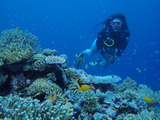
The Explorer Case Study organizing framework helps Explorers organize relevant information about their work to better communicate and engage with audiences. It can also be used as a teaching and communication tool to show the application of a concept, the evolution of a project over a period of time, or to define and to resolve issues or problems.

n 2021, the United States saw the addition of 851 new electric generating and storage units with at least 1 MW capacity, totaling 37,769 MW of new capacity. Wind and solar accounted for 79% of this new capacity, followed by natural gas (11%) and storage (9%).

Explore the global history of nuclear reactors from 1951 to 2022. This visualization showcases 626 operational reactors, highlighting the dominance of pressurized light water reactors (PWRs). Different reactor types exhibit geographic patterns, with retired reactors and ongoing upgrades observed in various countries. The average age of reactors in the United States was 41 years in 2021.

The use of biomass by humans can be traced back at least 1 million years to the controlled use of fire. However, the generation of electricity from biomass, known as biopower, is a more recent development. One of the earliest biopower plants was the São José da Estiva power station in Brazil, which began operating in 1900.

In 2020, 437 new solar electricity projects worldwide added a total capacity of 38,941 MW. The largest project was the 1348 MW Karapınar YEKA-1 solar farm in Turkey. Asia, North America, and Europe were the main contributors to solar capacity, with China leading with 23% of the global additions.

Explore world wind power capacity added in 2020
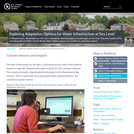
In Massachusetts, Manchester-by-the-Sea's wastewater treatment plant is located right on the coast. The town's water utility is working with the EPA's Climate Ready Water Utilities program to consider its adaptation options.
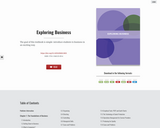
The author's goals in writing Exploring Business were simple: (1) introduce students to business in an exciting way and (2) provide faculty with a fully developed teaching package that allows them to do the former. Toward those ends, the following features are included in this text:1- Integrated (Optional) Nike Case Study: A Nike case study is available for instructors who wish to introduce students to business using an exciting and integrated case. Through an in-depth study of a real company, students learn about the functional areas of business and how these areas fit together. Studying a dynamic organization on a real-time basis allows students to discover the challenges that it faces, and exposes them to critical issues affecting the business, such as globalization, ethics and social responsibility, product innovation, diversity, supply chain management, and e-business.2- A Progressive (Optional) Business Plan: Having students develop a business plan in the course introduces students to the excitement and challenges of starting a business and helps them discover how the functional areas of business interact. This textbook package includes an optionalintegrated business plan project modeled after one refined by the author and her teaching team over the past ten years.3- AACSB Emphasis: The text provides end-of-chapter questions, problems, and cases that ask students to do more than regurgitate information. Most require students to gather information, assess a situation, think about it critically, and reach a conclusion. Each chapter presents ten Questions and Problems as well as five cases on areas of skill and knowledge endorsed by AACSB: Learning on the Web, Career Opportunities, The Ethics Angle, Team-Building Skills, and The Global View. More than 70% of end-of-chapter items help students build skills in areas designated as critical by AACSB, including analytical skills, ethical awareness and reasoning abilities, multicultural understanding and globalization, use of information technology, and communications and team oriented skills. Each AACSB inspired exercise is identified by an AACSB tag and a note indicating the relevant skill area.4- Author-Written Instructor Manual (IM): For the past eleven years, Karen Collins has been developing, coordinating and teaching (to over 3,500 students) an Introduction to Business course. Sections of the course have been taught by a mix of permanent faculty, graduate students, and adjuncts.

The textbook is for individuals who teach the basic public speaking course.

Welcome to this Edu-Metaverse and Smart Education Curriculum! This curriculum was developed by ChatGPT, a large language model trained by OpenAI, through questions and interactions with a learner.ChatGPT. (2023, March 29)

Son muy comunes
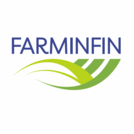
The learning resources presented here have been developed through an ERASMUS+ project for adult education entitled “FARMINFIN: Farming concepts and innovative funding/financing” (Project Nº: 2019-1-BE01-KA202-050397) carried out between 2019 and 2021.
The FARMINFIN project provides farmers with the needed competences for the implementation of innovative financing means tailored adequately for their own farms, entrepreneurial approach and personal circumstances.
FARMINFIN training material is aimed at young farmers taking over the business of their parents or simply aiming at business development. For them it is very important to have a solid financial basis for their agricultural businesses!
FARMINFIN has developed a web-based app where you can access to all the project’s training materials which are available in 7 languages: English, French, German, Spanish, Italian, Czech and Swedish. Through our learning platform you will be able to:
1. Get an overview of the actual situation of innovative financing in family farms in Europe and the available financing tools.
2. Gain knowledge and experience from selected best practices across Europe.
3. Foster professional handling of innovative financing means by farmers.
4. Strengthen economic and socio-economic viability of family farms, and therefore deliver added value to rural development.
The training resources you will find are the following:
SUMMARY REPORT: here you will find an overview of the situation of alternative ways of financing in the farming sector in Europe. The report provides a picture of the common findings across participating project countries, which have been analysed in more detail. You will find also in this section a downloadable annex that graphically shows all the data collected during the development of the report and can be viewed in detail segmented by country.
CATALOGUE: In the catalogue you will find not only a list of the main subsidies’ lines and general financing products, but also the financing products adapted to agriculture and more importantly, a large catalogue of the main products of alternative or innovative financing illustrated with a diagram showing the actors involved and the relationships between them. More specifically, the catalogue has identified:
- 14 of the main lines of subsidies.
- Main general funding products categorised into:
o Public sector (both European and national);
o Short-term private sector (11 tools identified);
o Long-term private sector (8 tools identified).
- Main financing products adapted to agriculture, for the agricultural, livestock and forestry sector.
- Main innovative financing products, where a total of 21 innovative financing tools have been catalogued in detail, including diagrams to illustrate how they work.
BEST PRACTICES: in this section you will find a series of 17 examples of farms across Europe that represent a wide range of best practices in the implementation of innovative financing schemes in the farming sector. Through this section you will learn from real experiences, reading about farmer’s problems related to financing and how they solved them. Learning from existing experiences will surely inspire you.
TRAINING MODULES: learning materials plenty of tips and suggestions on how to deal with relevant topics around the financing of your farm. In addition to the prepared contents of the modules, there is an opportunity to self-test your initial knowledge before taking the module and there is also a test at the end of the module to see whether you understood the contents. The modules also include useful templates, canvas and tools to be used in your learning pathway as well as in your professional activity.
For all components of the learning platform, information is provided in a comprehensive and user-friendly design and the materials can also be downloaded in PDF format.

Welcome to the FEMCON Video Showcase, your gateway to inspiring stories from women and men in the construction industry across Ireland, Spain, Poland, and Germany. Our collection of video interviews highlights the experiences, challenges, and successes of females in construction, showcasing the vital role women play in this dynamic field. At FEMCON, we aim to promote gender equality in construction by sharing real-life stories from professionals who are making a difference. Through our video interviews, we hope to inspire more women to join the industry and foster an inclusive environment where everyone can thrive.
Explore our videos to hear directly from women and men who are breaking barriers and challenging stereotypes. Learn about their journeys, the obstacles they've overcome, and their visions for a more diverse and equitable construction industry. Women bring unique perspectives, skills, and strengths to construction. Their contributions are essential for innovation, creativity, and sustainable growth in the industry. Discover why gender diversity is not just important but necessary for the future of construction.
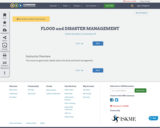
This resource gives basic details about the flood and flood management.

"Focus on 'Henry V'" is a peer-reviewed, multimedia, digital Open Educational Resource co-authored and co-produced by faculty, graduate students, and undergraduates on the innovative digital publishing platform Scalar. Chapters include guides to early printed editions, sources, and performance and cinematic histories of the play, as well as teaching resources and in-depth case-studies of particular scenes. All chapters include rich multimedia and audio recordings of body text and image captions. In addition to a traditional Table of Contents, the digital book allows users to navigate the materials through multiple pathways and visualizations. In this way the book offers not only a cutting-edge, renewable OER for college and K-12 teachers but also a model for maximizing the affordances of the digital medium.